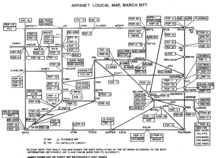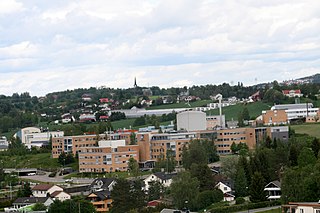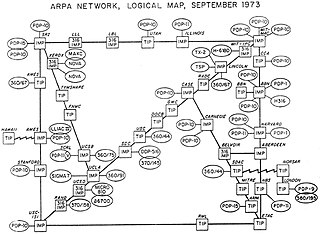

NORSAR is a foundation established in 1968 as part of the Norwegian-US agreement for the detection of earthquakes and nuclear explosions. [1] [2] [3] The name derives from the foundation's original project, the Norwegian Seismic Array.


NORSAR is a foundation established in 1968 as part of the Norwegian-US agreement for the detection of earthquakes and nuclear explosions. [1] [2] [3] The name derives from the foundation's original project, the Norwegian Seismic Array.
Located at Kjeller, north of Oslo, NORSAR runs and maintains seismic arrays in Norway and it is the designated Norwegian National Data Centre for the Comprehensive Nuclear Test Ban Treaty. [4] NORSAR conducts basic seismological research, develops software and provides consultancy for the petroleum industry. [5]

NORSAR was the first non-US site included in ARPANET in June 1973. Its connection went via the Tanum Earth Station in Sweden to the Seismic Data Analysis Center (SDAC) in Virginia, United States. [6] [7] In turn, NORSAR provided the connection point for ARPANET to spread to Peter Kirstein's research group at University College London (UCL) the following month in July 1973. Connecting through NORSAR, the Norwegian Defence Research Establishment (NDRE), along with UCL and RSRE in Britain, were involved in testing TCP/IP. UCL provided a gateway between the ARPANET and UK academic computer networks, the first heterogenous international computer network. [8] In early 1982, NORSAR and UCL left the ARPANET and began to use TCP/IP over SATNET, becoming two of the first nodes on the Internet. [9]
Since 1999, NORSAR has been an independent research foundation. [10]

The history of the Internet has its origin in the efforts of scientists and engineers to build and interconnect computer networks. The Internet Protocol Suite, the set of rules used to communicate between networks and devices on the Internet, arose from research and development in the United States and involved international collaboration, particularly with researchers in the United Kingdom and France.

The Internet is the global system of interconnected computer networks that uses the Internet protocol suite (TCP/IP) to communicate between networks and devices. It is a network of networks that consists of private, public, academic, business, and government networks of local to global scope, linked by a broad array of electronic, wireless, and optical networking technologies. The Internet carries a vast range of information resources and services, such as the interlinked hypertext documents and applications of the World Wide Web (WWW), electronic mail, telephony, and file sharing.
Internetworking is the practice of interconnecting multiple computer networks, such that any pair of hosts in the connected networks can exchange messages irrespective of their hardware-level networking technology. The resulting system of interconnected networks are called an internetwork, or simply an internet.
The Internet protocol suite, commonly known as TCP/IP, is a framework for organizing the set of communication protocols used in the Internet and similar computer networks according to functional criteria. The foundational protocols in the suite are the Transmission Control Protocol (TCP), the User Datagram Protocol (UDP), and the Internet Protocol (IP). Early versions of this networking model were known as the Department of Defense (DoD) model because the research and development were funded by the United States Department of Defense through DARPA.
A datagram is a basic transfer unit associated with a packet-switched network. Datagrams are typically structured in header and payload sections. Datagrams provide a connectionless communication service across a packet-switched network. The delivery, arrival time, and order of arrival of datagrams need not be guaranteed by the network.
In telecommunications, packet switching is a method of grouping data into packets that are transmitted over a digital network. Packets are made of a header and a payload. Data in the header is used by networking hardware to direct the packet to its destination, where the payload is extracted and used by an operating system, application software, or higher layer protocols. Packet switching is the primary basis for data communications in computer networks worldwide.
Telecommunications in Norway are relatively advanced. There are about as many cellular phone subscription as there are inhabitants in the country, while the number of fixed line telephone subscriptions is declining towards 800,000. As of 2006, 79% of the population had access to internet at home, rising to 95% by 2012.

Kjeller is a village located near Lillestrøm in the municipality of Lillestrøm, Norway. It is located 25 kilometers north-east of Oslo.

The Advanced Research Projects Agency Network (ARPANET) was the first wide-area packet-switched network with distributed control and one of the first computer networks to implement the TCP/IP protocol suite. Both technologies became the technical foundation of the Internet. The ARPANET was established by the Advanced Research Projects Agency (ARPA) of the United States Department of Defense.
The computer file hosts is an operating system file that maps hostnames to IP addresses. It is a plain text file. Originally a file named HOSTS.TXT was manually maintained and made available via file sharing by Stanford Research Institute for the ARPANET membership, containing the hostnames and address of hosts as contributed for inclusion by member organizations. The Domain Name System, first described in 1983 and implemented in 1984, automated the publication process and provided instantaneous and dynamic hostname resolution in the rapidly growing network. In modern operating systems, the hosts file remains an alternative name resolution mechanism, configurable often as part of facilities such as the Name Service Switch as either the primary method or as a fallback method.
NORDUnet is an international collaboration between the National research and education networks in the Nordic countries.
Peter Thomas Kirstein was a British computer scientist who played a role in the creation of the Internet. He made the first internetworking connection on the ARPANET in 1973, by providing a link to British academic networks, and was instrumental in defining and implementing TCP/IP alongside Vint Cerf and Bob Kahn.

A computer network is a set of computers sharing resources located on or provided by network nodes. Computers use common communication protocols over digital interconnections to communicate with each other. These interconnections are made up of telecommunication network technologies based on physically wired, optical, and wireless radio-frequency methods that may be arranged in a variety of network topologies.
A network host is a computer or other device connected to a computer network. A host may work as a server offering information resources, services, and applications to users or other hosts on the network. Hosts are assigned at least one network address.
The Internet in Norway is available through Fiber or Mobile. The country code top level domain is .no.

The United Kingdom has been involved with the Internet throughout its origins and development. The telecommunications infrastructure in the United Kingdom provides Internet access to homes and businesses mainly through fibre, cable, mobile and fixed wireless networks, with the UK's 140-year-old copper network, maintained by Openreach, set to be withdrawn by December 2025.

Pål Spilling was a Norwegian Internet pioneer and professor at the University of Oslo and the UNIK Graduate Center at Kjeller in Norway.

SATNET, also known as the Atlantic Packet Satellite Network, was an early satellite network that formed an initial segment of the Internet. It was implemented by BBN Technologies under the direction of the Advanced Research Projects Agency.
A long-running debate in computer science known as the Protocol Wars occurred from the 1970s to the 1990s, when engineers, organizations and nations became polarized over the issue of which communication protocol would result in the best and most robust computer networks. This culminated in the Internet–OSI Standards War in the 1980s and early 1990s, which was ultimately "won" by the Internet protocol suite (TCP/IP) by the mid-1990s and has since resulted in most of the competing protocols disappearing.